On the Coast
Los Angeles to Vancouver by train
by Sarah Shuckburgh
Sarah Shuckburgh boards the Coast Starlight for a
slow but soothing trip along North America’s western flank.
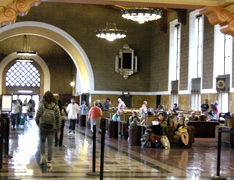 Grand Central Station in Los Angeles is spectacular –
gleaming white outside, faded art deco grandeur inside, with
huge, firmly-upholstered leather armchairs. But the
glamorous days of rail travel are long gone, Grand Central Station in Los Angeles is spectacular –
gleaming white outside, faded art deco grandeur inside, with
huge, firmly-upholstered leather armchairs. But the
glamorous days of rail travel are long gone,
and today
nobody looks like Cary Grant. I queued for my boarding pass
behind a family with luggage in plastic bags. Two tousled
urchins
peered at me as their mother checked in. “She’s
drunk,” the steward shrugged, watching her go.
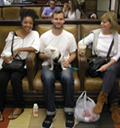 On board the double-decker train, most passengers settled
into their allocated seats and tried to sleep, but I went in
search of the observation car and found a wonderfully airy
carriage with banquettes facing a wall of glass. And in this
excellent spot I stayed for the next 12 hours. On board the double-decker train, most passengers settled
into their allocated seats and tried to sleep, but I went in
search of the observation car and found a wonderfully airy
carriage with banquettes facing a wall of glass. And in this
excellent spot I stayed for the next 12 hours.
The
Coast Starlight, Amtrak’s flagship train, runs between Los
Angeles and Seattle, but today I was travelling as far as
San Francisco. As we chugged out of LA, the panorama of
parking lots, industrial estates, trailer parks and palms
gradually gave way to a beautiful, craggy coastline. For
hours, we clattered along the beach, waves breaking on to
the stony shore just beside us. At times, the Coastal
Highway ran parallel to the track, the cars racing past us.
When the highway curved inland, we rolled on through miles
of uninhabited wilderness.

The pace of travel was soothing. A far cry from European
high-speed railways, Amtrak’s passenger services move
slowly, stopping frequently in sidings to allow immensely
long freight trains to rattle past. West-coast motorists and
pedestrians don’t expect to encounter trains, and to avoid
collisions our train sounded a horn and slowed to a walking
pace whenever we approached a road. That afternoon, we were
held up for an hour while a car was towed from the track.
Apart from local commuter services, there are only a handful
of US passenger routes. It seems odd, when railroads played
such a crucial role in 19th century America, that trains
have been so eclipsed.
Everyone in the observation car wanted to chat, and soon I
had half a dozen new friends, including bubbly Rosetta, a
crane-driver and devout Catholic; 30-year-old Scott, an
attendant on the Indiana Jones ride at Disneyland, thrilled
to be on his first-ever paid leave; Karen, a child
development specialist who disapproved of cars and planes;
and Kevin, who declared London 2012 a disaster compared to
the Los Angeles Olympics which made a profit of $1 million.
None of my observation-car companions had visited Britain
but they were all highly critical of our socialist
healthcare system.
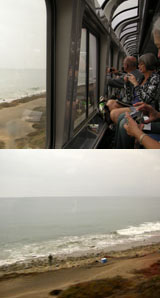 While we chatted, Rosetta kept me informed – “those folks
are picking year-round strawberries”; “that’s a Californian
winery”; “the main crop hereabouts is turf”; “that’s a
turkey-hawk in the sky”. Scott hadn’t travelled by train
before, and was astonished when we drew into a station with
two platforms: “Boy, this is like a railway museum”. While we chatted, Rosetta kept me informed – “those folks
are picking year-round strawberries”; “that’s a Californian
winery”; “the main crop hereabouts is turf”; “that’s a
turkey-hawk in the sky”. Scott hadn’t travelled by train
before, and was astonished when we drew into a station with
two platforms: “Boy, this is like a railway museum”.
We saved each other’s places on the banquette to allow
visits to the snack bar. I tried the promising-looking
dining car, with crisp white tablecloths and fresh flowers.
Alas, the food was poor – served on plastic plates,
tasteless, dry and pricey – but the conversation was lively.
At lunch (as we chugged past Santa Barbara, between ocean
and high chaparral), I shared a table with Cheryl and Chuck,
returning from an all-expenses-paid trip to the Judge Judy
Show. They were thrilled: Judge Judy had awarded them a huge
sum for a road-rage incident. As our train rolled through a
restricted military reserve, Chuck pointed out a missile
base with space-shuttle launch pads and runways. “I worked
there as a medical orderly”, he told me. “Once, a shuttle
crashed on take-off and landed on a farm over that hill. I
had to collect the wounded farm workers.”
At supper (passing the vineyards of Salinas, John
Steinbeck’s home town), I sat with Don and Joan, who were on
a week-long round trip from Chicago, taking a break from
their 11 children, 34 grandchildren and (thus far) 24
great-grandchildren. “We sure do have a big family. Oh my!”
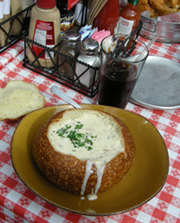
Back in the observation car, Rosetta, Karen, Kevin, Scott
and I watched darkness fall, and looked (through the glass
roof) for the comets that Scott knew were forecast. The
bedraggled urchins wandered by, and asked us how much food
cost. Rosetta immediately bought supper for the children and
their mother. “We Hispanics can’t bear to see children
suffering,” she said.
An hour behind schedule, at 11pm, we reached Emeryville. I
waved goodbye to my friends and took a taxi across the bay
to San Francisco. Lying cosily in my hotel bed, I could
still feel the motion of the train, and imagined it
trundling on through the night.
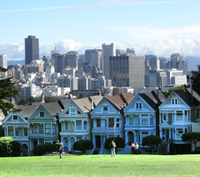 I
spent two lovely days in San Francisco, dining on clam
chowder and sourdough bread, exploring Fisherman’s Wharf
with its historic ships and basking sea lions, and visiting
the Waterfront Exhibition which traces the history of San
Francisco. The indigenous Yelamu fished here for 10,000
years, until the arrival in the 1790s of Spaniards and
Mexicans, and, 50 years later, the traders who were the real
winners during the gold rush: boat builders, coffee sellers, chocolatiers (including Ghiradelli, still in business), and
tailors, including Levi Strauss (his headquarters is still
here). The next day, I rode the trolley up steep streets,
admired painted redwood villas, and walked across the
blustery Golden Gate Bridge. In the evening, I took the
Amtrak bus back to Emeryville and rejoined the Coast
Starlight train. I
spent two lovely days in San Francisco, dining on clam
chowder and sourdough bread, exploring Fisherman’s Wharf
with its historic ships and basking sea lions, and visiting
the Waterfront Exhibition which traces the history of San
Francisco. The indigenous Yelamu fished here for 10,000
years, until the arrival in the 1790s of Spaniards and
Mexicans, and, 50 years later, the traders who were the real
winners during the gold rush: boat builders, coffee sellers, chocolatiers (including Ghiradelli, still in business), and
tailors, including Levi Strauss (his headquarters is still
here). The next day, I rode the trolley up steep streets,
admired painted redwood villas, and walked across the
blustery Golden Gate Bridge. In the evening, I took the
Amtrak bus back to Emeryville and rejoined the Coast
Starlight train.
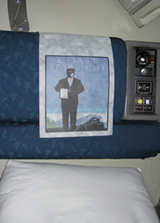 This time I was a First Class passenger with a ‘roomette’ –
a minuscule cubicle with floor space no bigger than my feet
and nowhere to put anything. Trying to unpack, I put my
Kindle on the bunk, then knelt on it and cracked the screen.
Dim lights made reading a book impossible. One good thing: I
was travelling alone. Double occupancy would involve the top
bunk, a windowless shelf allowing neither traveller to sit
up in bed. This time I was a First Class passenger with a ‘roomette’ –
a minuscule cubicle with floor space no bigger than my feet
and nowhere to put anything. Trying to unpack, I put my
Kindle on the bunk, then knelt on it and cracked the screen.
Dim lights made reading a book impossible. One good thing: I
was travelling alone. Double occupancy would involve the top
bunk, a windowless shelf allowing neither traveller to sit
up in bed.
I wasn’t too keen on my roomette, but I slept like a log,
while outside, giant redwoods and mystic mountains glided by
in the darkness. I awoke to a glittering landscape of snow.
Only now, nearly twenty-four hours after leaving LA, was the
train leaving the vast state of California and crossing into
Oregon. Snow fell steadily as we passed silvery lakes dotted
with islands and fringed with conifers. The palms and heat
of LA seemed very distant.
We in Sleeper Class were a notch up from Coach, with
complimentary food from a more elaborate menu. For breakfast
I ordered tasty crab-cakes with potato wedges, bacon and
biscuits with gravy. “You wanted hot tea?” the waitress
queried, bringing tepid water, a wrapped Lipton’s teabag and
a sachet of creamer. When I complained, politely, she
brought even cooler water and said “Why not use that bag
again?” There is a reason why this Cascades area of the
Pacific North-West is known as the ‘Coffee Coast’. Locals
could not explain why they drink so much coffee, but they
all agreed that they hate tea.
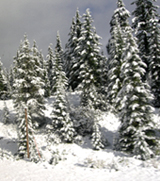 First Class facilities included a cinema (2 shows a day),
and a glass-walled ‘parlor’ where I spent the morning in a
comfortable armchair, listening to Johnny Cash train songs,
selected for me by my daughter. Railroads have played a huge
role in American folk, blues, country, rock and roll, and
jazz. Johnny Cash’s chicka-boom rhythms perfectly matched
the clickety-clack of the train, and as he sang about
lonesome whistles blowin’ and slow trains a-comin’, I gazed
at the slowly evolving landscape, catching glimpses of
strangers’ lives - lads hurling logs on to a pickup truck,
men shovelling snow from a driveway, and, indoors,
television screens flickering. First Class facilities included a cinema (2 shows a day),
and a glass-walled ‘parlor’ where I spent the morning in a
comfortable armchair, listening to Johnny Cash train songs,
selected for me by my daughter. Railroads have played a huge
role in American folk, blues, country, rock and roll, and
jazz. Johnny Cash’s chicka-boom rhythms perfectly matched
the clickety-clack of the train, and as he sang about
lonesome whistles blowin’ and slow trains a-comin’, I gazed
at the slowly evolving landscape, catching glimpses of
strangers’ lives - lads hurling logs on to a pickup truck,
men shovelling snow from a driveway, and, indoors,
television screens flickering.
My new companions were older, more widely travelled and more
affluent than my friends in Coach Class, but they shared the
same dress code of trainers and baseball caps or unseasonal
cotton sunhats. At lunch (passing Eugene, HQ of Nike), I met
a couple who, like me, were sleeping in a roomette. I felt
thoroughly ashamed that I had found fault with mine. The
husband, aged 84, had cheerfully clambered up to the top
bunk. “Some folks choose to pay more for a deluxe cabin with
a double bed and a private bathroom, but we like our
roomette, don’t we, honey?” declared this intrepid old gentleman. He had visited London as a teenager in 1946,
wearing Levi jeans which at that time marked him as an
American. In the Mall, he told me, a car drew up, a window
wound down and Queen Mary looked out. “Young man,” she said,
“Thank you for helping us to win the war.”
During the afternoon, the snow disappeared. We chugged
through the vast conurbation of Portland and then crossed
from Oregon into Washington State. My supper companions were
two elderly sisters with not a word of English between them,
despite having lived in California for 44 years. They
recited loud Spanish prayers before tucking into their chipotle burgers.
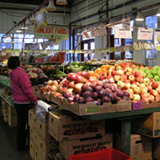 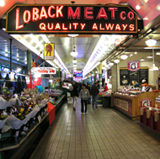
I alighted at Seattle (behind schedule as usual - 2 hours
late) for another night in a hotel. Next morning, I explored
Pike Place, a historic market with fruit and vegetable
stalls, fishmongers who fling their catch over the counter
to be wrapped, hippy craft stalls, and the world’s first
Starbucks. There are coffee shops everywhere in Seattle –
good for sheltering from the chilly drizzle. I gave up the
quest for tea, and enjoyed the drink for which the Cascades
Coast is renowned.
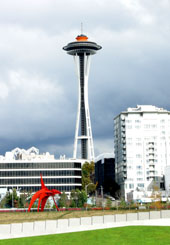 Seattle’s waterfront is marred by a two-storey concrete
viaduct carrying heavy traffic, but from a distance, on a
harbour cruise, I admired the city’s cluster of elegant
skyscrapers, its impressive docks with cargo ships the size
of cathedrals, and its curious Space Needle, 600 feet high.
To the north, the noisy viaduct swings inland, and here,
overlooking the glittering bay, is a peaceful sculpture
park, its sloping meadows planted with different local
ecosystems, reflecting Native Americans’ intimate knowledge
of the Pacific North West landscape. Seattle’s waterfront is marred by a two-storey concrete
viaduct carrying heavy traffic, but from a distance, on a
harbour cruise, I admired the city’s cluster of elegant
skyscrapers, its impressive docks with cargo ships the size
of cathedrals, and its curious Space Needle, 600 feet high.
To the north, the noisy viaduct swings inland, and here,
overlooking the glittering bay, is a peaceful sculpture
park, its sloping meadows planted with different local
ecosystems, reflecting Native Americans’ intimate knowledge
of the Pacific North West landscape.
 That evening, I boarded another train for the final leg of
my journey up the Cascades Coast to Vancouver. The young man
sitting next to me introduced himself as a First Nation
wood-carver. I told him that I had enjoyed seeing Native
American carvings, masks and woven baskets at the Seattle
Art Gallery that afternoon. As our train trundled into
Canada, he told me the story of the 19th-century Chief
Seattle, after whom the city was named. This peace-loving,
forward-looking Chief befriended the pioneers, rather than
fighting them, and encouraged a mutually rewarding cultural
exchange. Part of Chief Seattle’s legacy is that today, on
this North-West Pacific coast, Native American arts
flourish. “You need to visit again next fall”, he said.
“Vancouver art gallery is holding a major exhibition of
works by Charles Edenshaw, the greatest of all First Nation
artists. He died nearly 100 years ago, but I reckon we’re
all influenced by him.” That evening, I boarded another train for the final leg of
my journey up the Cascades Coast to Vancouver. The young man
sitting next to me introduced himself as a First Nation
wood-carver. I told him that I had enjoyed seeing Native
American carvings, masks and woven baskets at the Seattle
Art Gallery that afternoon. As our train trundled into
Canada, he told me the story of the 19th-century Chief
Seattle, after whom the city was named. This peace-loving,
forward-looking Chief befriended the pioneers, rather than
fighting them, and encouraged a mutually rewarding cultural
exchange. Part of Chief Seattle’s legacy is that today, on
this North-West Pacific coast, Native American arts
flourish. “You need to visit again next fall”, he said.
“Vancouver art gallery is holding a major exhibition of
works by Charles Edenshaw, the greatest of all First Nation
artists. He died nearly 100 years ago, but I reckon we’re
all influenced by him.”
 Vancouver is a remarkable city, as densely populated as
Manhattan, with urban sprawl prevented by mountains, water
and the US border. Stanley Park has1000 acres of protected
temperate rainforest, home to raccoons, coyotes and beavers.
I made the most of my short stay by hiring a local guide.
Paul adored his city, warts and all. “There’s a huge gap
between rich and poor in Vancouver,” he told me, as we
passed drug-dependency projects and shelters for the
homeless. “We have Canada’s wealthiest, and also Canada’s
most destitute.” In the bay, seaplanes took off towards
luxury North Shore homes, against a dramatic backdrop of
snowy mountains. Paul showed me historic streets with
stately stone buildings; we walked part of the 20-mile
seawall which encircles the city; we visited a farmers’
market with artisanal workshops. And of course I had to try
Vancouver’s excellent coffee. Vancouver is a remarkable city, as densely populated as
Manhattan, with urban sprawl prevented by mountains, water
and the US border. Stanley Park has1000 acres of protected
temperate rainforest, home to raccoons, coyotes and beavers.
I made the most of my short stay by hiring a local guide.
Paul adored his city, warts and all. “There’s a huge gap
between rich and poor in Vancouver,” he told me, as we
passed drug-dependency projects and shelters for the
homeless. “We have Canada’s wealthiest, and also Canada’s
most destitute.” In the bay, seaplanes took off towards
luxury North Shore homes, against a dramatic backdrop of
snowy mountains. Paul showed me historic streets with
stately stone buildings; we walked part of the 20-mile
seawall which encircles the city; we visited a farmers’
market with artisanal workshops. And of course I had to try
Vancouver’s excellent coffee.
The journey from Los Angeles to Vancouver could be done by
car in 24 hours, if you drove non-stop. It would take less
than 3 hours by air. I spent 40 hours on the train, but what
enjoyable, stress-free hours they were. I shared with Johnny
Cash a feeling of freedom as the wilderness rolled by and we
left our troubles behind. I took a week to cover the 1300
miles, but another time I’d like to disembark at twice as
many stations, and take even longer. My fellow travellers
may not have been as glamorous as Cary Grant, but the
railroad is still a great way to travel.
 Inside
Track: Inside
Track:
- Buy delicious Mexican food from Olvera Street before you board at
Los Angeles.
- First Class passengers can check their emails with free (but
intermittent) wireless internet
connection in the parlor.
- Book a deluxe bedroom if you can afford it. If two of you share a
roomette, make sure one is
athletic and slim enough to scramble on to the top bunk. Roomettes are quite
cosy and
comfortable for one, and turn into two facing seats during the day. A cheaper option is to spend
the night
sitting in Coach Class.
- People love to talk. If you don’t feel like chatting to
strangers, wear headphones, or stay in
your cabin.
- The train stops at stations for long enough for a breath of fresh
air, but don’t wander from
the platform.
- Coast Starlight and Cascades trains run to the same schedule each
day. You can arrange
to disembark at any station, and rejoin the train at the same time on
another day.
- Bring a shawl or extra jerseys because the carriages can be
chilly.
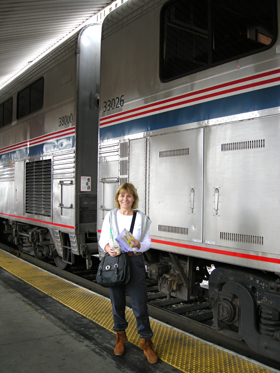 In Downtown Los Angeles: In Downtown Los Angeles:
Where to stay:
- Millennium Biltmore Hotel. This historic art deco hotel is
near
the station, and is also convenient for major
Downtown attractions
Where to Eat:
- Olvera Street, right by the station, is the oldest street in
Los
Angeles, with a wonderful Mexican market stalls and
restaurants. It is classed as a California State
Historic Park.
Visit the Avila Adobe, built in 1818, the
oldest house in
Los Angeles
- Perch: a rooftop bar and bistro with great views. Bohemian
and
whimsical, with French food, cocktails, outdoor fire-pits,
live music
What to Do
Downtown attractions near the station include L.A.Live
with
live shows and concerts, Ahmanson Theatre, Walt Disney
Concert Hall with concerts by the LA
Philharmonic, Dodger
baseball Stadium
In San Francisco:
Where to stay:
From Emeryville Station, take the Amtrak bus to
Fisherman’s
Wharf. There are lots of hotels here, including
the Holiday Inn
with big, quiet rooms and an outdoor pool
Where to eat:
- Lou’s Fish Shack for sourdough bread bowl with clam chowder, or
cracked whole Dungeness crab
- Boudin Bakery, established 1849. See sourdough bread being made
and visit the bakery museum before you eat
What to do:
- On Fisherman’s Wharf: visit Hyde St Pier, with historic tall
ships, tiny dinghies that have been rowed across the
Atlantic, and dozens of other maritime exhibits,
including free entry to the Waterfront Exhibition. On Pier
39, avoid the
tacky tourist shops but take the boardwalk for lovely
views of the bay, and honking sea lions heaped on wooden
rafts.
- Big Bus double-decker sight-seeing. Hop on at Mason St on
Fisherman’s Wharf. It’s a good way to see a lot in one
day – for instance, hopping off at Alamo Square, Haight
Ashbury, the Japanese Tea Garden in Golden Gate Park
and the Golden Gate bridge.
In Seattle:
Where to stay:
- The Warwick Hotel: huge rooms with views of the Space Needle and
the bay. Well situated for exploring Seattle
on foot
- The Edgewater Hotel: a quirky hotel, built on a jetty, popular in
its1960s heyday with the Beatles, Monkees, Mamas
and Papas, Beach Boys & Rolling Stones whose
photographs are still displayed.
Where to eat:
- Pike Place Market: make sure you try the local salmon, smoked
over alder-wood
- Matt's in the Market, sophisticated American cooking. Good views
from the third floor of the Corner Market Building,
by the famous neon clock
- Starbucks: there are many branches, including the world’s first
at 1912 Pike Place, and one in historic
Pioneer Square.
What to do:
- Don’t carry an umbrella – put your hood up, or be like a local
and enjoy the drizzle
- Don’t miss Pike Place market – 100 years old and still going
strong
- Seattle Art Museum
- Take a harbour cruise
- Ride the Great Wheel
- Stroll north along the waterfront to the Olympic Sculpture Park
(free entry) which includes works by Alexander
Calder and Louise Bourgeois. Nearby Myrtle Edwards Park
is a peaceful waterside strip of grass and trees
away from the roar of traffic.
In Vancouver:
Where to stay:
Stay in Delta Vancouver Suites, with amazing views over
water, docks, city and mountains
Where to eat:
- Vancouver Art Gallery is great for lunch, with homecooked dishes,
including Namaino, a favourite desert for locals
- Granville Island farmers’ market: huge assortment of top quality
fresh food, especially fish, specialty fast food, bakery
- Caffé Artigiano, for connoisseurs of coffee, owned by local Todd
Pollock. Vancouver’s upmarket answer to Starbucks
What to do:
- Walk the seawall, a promenade almost at the level of the water,
which runs for 20 miles from Canada Place round
Stanley Park and False Creek to Kitsilano, and is
dotted with interesting sculptures.
- Take the small ferry from Sunset Beach by Burrard Bridge to
Granville Island and its farmers’ market and artisan
workshops such as Broom Co – assorted besoms made by
sisters Mary and Sarah Schwieger, who learnt their
trade from their parents.
- Take a private guided tour with a well-informed local:
www.ToursByLocals.com
First published by the Telegraph
©SarahShuckburgh |